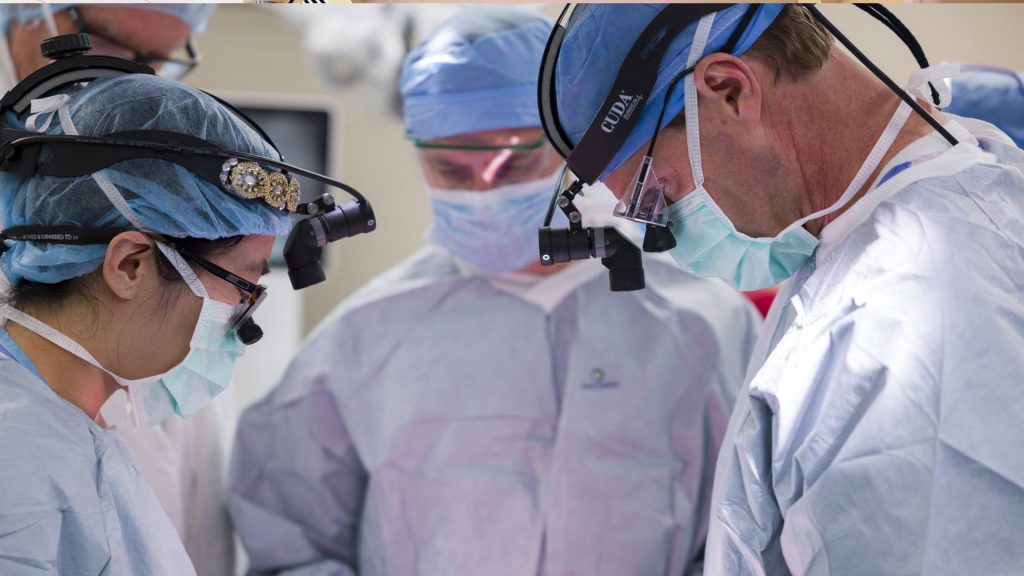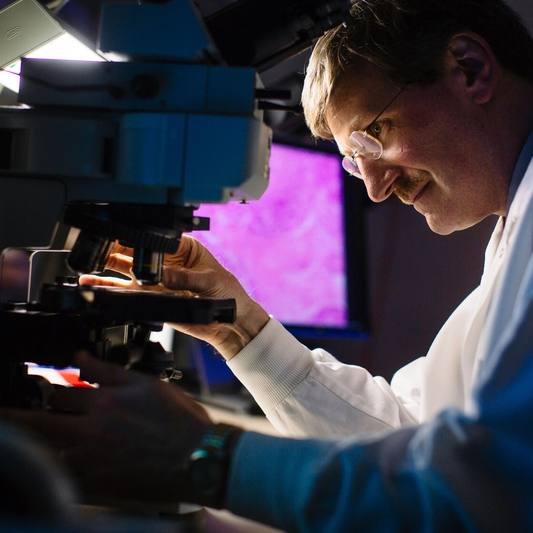-
Research
Teamwork and research play a key role in Mayo Clinic’s first larynx transplant

Surgeons at Mayo Clinic in Arizona perform a total larynx transplant
Mayo Clinic's unique culture of teamwork and collaboration, hallmarks since the days of Dr. Will and Dr. Charlie Mayo, laid the foundation for Mayo's first larynx transplant that happened in Arizona. This groundbreaking surgery, only the third larynx transplant in the U.S., continues the innovative work for which the Mayo brothers were known.
A team of six surgeons and 20 support staff combined expertise from the Department of Otolaryngology with the mastery of the Department of Transplantation in an extraordinary 21-hour operation. They transplanted a donor larynx in a 59-year-old patient with cancer whose damaged larynx hampered his ability to talk, swallow and breathe.
The larynx transplant was a composite neck transplant that included at least eight different types of tissue, including the larynx, upper trachea, upper esophagus, pharynx, thyroid glands, parathyroid glands, nerves and blood vessels — commonly called the throat. It's a rare type of transplant known as a vascular composite allograft. The larynx — also called the voice box — is a delicate organ composed of tissue, cartilage and joints that must be able to move after transplantation.
Watch: Teamwork and research played a key role the first total larynx transplant at Mayo Clinic
Journalists: Broadcast-quality video pkg (1:56) in the downloads at the end of this post. Please courtesy: "Mayo Clinic News Network." Read the script.
A team science approach to larynx transplantation
This complex surgery is an example of Mayo Clinic's team science approach, to advance research innovation to patient care.
"Mayo Clinic's team science approach made it possible for us to offer this type of a transplant on a scale that was previously unattainable," says David Lott, M.D., chair of the Arizona Department of Otolaryngology and lead surgeon. "All transplants are complex, but there are more tissue types and moving parts with laryngeal transplantation than other transplants."
In any transplant, the body's immune system flags the donor organ as a foreign object and tries to reject it. A key to success is identifying the right immunosuppressant drugs that allow the body to recognize and accept the new tissue. That was exceptionally challenging in this complex surgery that required eight types of donor tissue. This first transplant will serve as a baseline for understanding the various immune responses, quality of life and long-term sustainability of the larynx transplant.
"Our research laid the foundation for understanding the unique immunosuppressant needs of the patient after transplanting multiple types of tissues," says Dr. Lott. "Preclinical models helped us learn which medications could regulate the immune responses of the various different donor tissue with fewest potential side effects and still be powerful enough to prevent rejection."
This is also the first known larynx transplant in a patient with active cancer who was part of a clinical trial. Dr. Lott and the team will now conduct research aimed at establishing scientific evidence to support the first-ever clinical service line in laryngeal transplantation.
"Because this surgery is so rare, there are a lot of unknowns. We will continue our study of laryngeal transplantation in the patient's follow-up care to determine how well the new organ has restored his ability to talk, breathe and eat," says Dr. Lott. "Besides the quality-of-life issues, we want to study how well the transplanted tissues are functioning over time."
The initial focus of the larynx transplant study will be patients who have a voice box that is no longer functional due to previous cancer or traumatic injury. The team is not yet transplanting a donor larynx in a person who has had a total larynx removal — known as a laryngectomy. They hope to use the research to improve this surgery to make it possible for more patients, including those without a larynx, in the near future.
###
Dr. Lott is the chair of the Department of Otolaryngology in Arizona, director of the Head and Neck Regenerative Medicine Lab at Mayo Clinic, surgical director of the Larynx and Trachea Transplantation Program, and the associate director of the Mayo Clinic Center for Regenerative Biotherapeutics in Arizona. His team's research and practice seek to restore laryngeal and tracheal function through 3D-bioprinted implants and full organ transplantation
Additional members of the transplant team are:
Brent Chang, M.D., otolaryngology, head and neck surgeon.
Payam Entezami, M.D., otolaryngology
Michael Hinni, M.D., otolaryngology, head and neck surgeon.
Brittany Howard, M.D., otolaryngology, facial plastics and reconstruction surgeon.
Melissa Zheng, M.D., otolaryngology, laryngeal surgeon.
Girish Mour, M.B.B.S., transplant medical director
###
Related stories:
What is laryngeal chondrosarcoma?







